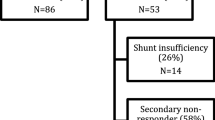Summary
Background. Although sporadic studies have described temporary external cerebrospinal fluid (CSF) lumbar drainage as a highly accurate test for predicting the outcome after ventricular shunting in normal pressure hydrocephalus (NPH) patients, a more recent study reports that the positive predictive value of external lumbar drainage (ELD) is high but the negative predictive value is deceptively low. Therefore, we conducted a prospective study in order to evaluate the predictive value of a continuous ELD, with CSF outflow controlled by medium pressure valve, in NPH patients.
Method. Twenty-seven patients with presumed NPH were admitted to our department and CSF drainage was carried out by a temporary (ELD) with CSF outflow controlled by a medium pressure valve for five days. All patients received a ventriculoperitoneal shunt using a medium pressure valve based upon preoperative clinical and radiographic criteria of NPH, regardless of ELD outcome. Clinical evaluation of gait disturbances, urinary incontinence and mental status, and radiological evaluation with brain CT was performed prior to and after ELD test, as well as three months after shunting.
Findings. Twenty-two patients were finally shunted and included in this study. In a three-month follow-up, using a previously validated score system, overall improvement after permanent shunting correlated well to improvement after ELD test (Spearman’s rho = 0.462, p = 0.03). When considering any degree of improvement as a positive response, ELD test yielded high positive predictive values for all individual parameters (gait disturbances 94%, 95% CI 71%–100%, urinary incontinence 100%, 95% CI 66%–100%, and mental status 100%, 95% CI 66%–100%) but negative predictive values were low (< 50%) except for cognitive impairment (85%, 95% CI 55%–98%).
Conclusion. This study suggests that a positive ELD-valve system test should be considered a reliable criterion for preoperative selection of shunt-responsive NPH patients. In case of a negative ELD-valve system test, further investigation of the presumed NPH patients with additional tests should be performed.
Similar content being viewed by others
References
PMcL Black RG Ojemann A Tzouras (1985) ArticleTitleCSF shunts for dementia, incontinence, and gait disturbance. Clin Neurosurg 32 632–651 Occurrence Handle3905156
IH Chen CI Huang HC Liu et al. (1994) ArticleTitleEffectiveness of shunting in patients with normal pressure hydrocephalus predicted by temporary, controlled-resistance, continuous lumbar drainage: a pilot study. J Neurol Neurosurg Psychiatry 57 1430–1432 Occurrence Handle7964828
Cummings JL, Benson DF (1992) Hydrocephalic dementia. In: Dementia: a clinical approach, 2nd edn. Butterworth Heinemann, Boston, pp 267–291
L Di Lauro M Viearini A Bollati (1986) ArticleTitleThe predictive value of 5 days diversion for shunting in normal pressure hydrocephalus. J Neurol Neurosurg Psychiatry 49 842–843
TD Fife (2003) ArticleTitleClinical features of normal pressure hydrocephalus. Barrow Qu 19 IssueID2 10–15
NR Graff-Radford JC Godersky (1986) ArticleTitleNormal-pressure hydrocephalus. Onset of gait abnormality before dementia predicts good surgical outcome. Arch Neurol 43 940–942 Occurrence Handle3741212
J Haan RTWM Thomeer (1988) ArticleTitlePredictive value of temporary external lumbar drainage in normal pressure hydrocephalus. Neurosurgery 22 388–391 Occurrence Handle3352890
CA Hakim R Hakim S Hakim (2001) ArticleTitleNormal pressure hydrocephalus. Neurosurg Clin North Am 36 IssueID4 761–772
AO Hebb MD Cusimano (2001) ArticleTitleIdiopathic normal pressure hydrocephalus: a systematic review of diagnosis and outcome. Neurosurgery 49 1166–1186 Occurrence Handle10.1097/00006123-200111000-00028 Occurrence Handle11846911
K Mori (2001) ArticleTitleManagement of idiopathic normal-pressure hydrocephalus: a multiinstitutional study conducted in Japan. J Neurosurg 95 970–973 Occurrence Handle11765841
JAL Vanneste P Augustijn C Dirven et al. (1992) ArticleTitleShunting normal pressure hydrocephalus: do the benefits outweigh the risks? A multicenter study and literature review. Neurology 42 54–59 Occurrence Handle1734324
JAL Vanneste (1994) ArticleTitleThree decades of normal pressure hydrocephalus: are we wiser now? J Neurol Neurosurg Psychiatry 57 1021–1025 Occurrence Handle8089664
R Walchenbach E Geoger RTWM Thomeer JAL Vannaste (2002) ArticleTitleThe value of temporary external lumbar CSF drainage in predicting the outcome of shunting on normal pressure hydrocephalus. J Neurol Neurosurg Psychiatry 72 503–506 Occurrence Handle11909911
Author information
Authors and Affiliations
Rights and permissions
About this article
Cite this article
Panagiotopoulos, V., Konstantinou, D., Kalogeropoulos, A. et al. The predictive value of external continuous lumbar drainage, with cerebrospinal fluid outflow controlled by medium pressure valve, in normal pressure hydrocephalus. Acta Neurochir (Wien) 147, 953–958 (2005). https://doi.org/10.1007/s00701-005-0580-9
Received:
Accepted:
Published:
Issue Date:
DOI: https://doi.org/10.1007/s00701-005-0580-9




